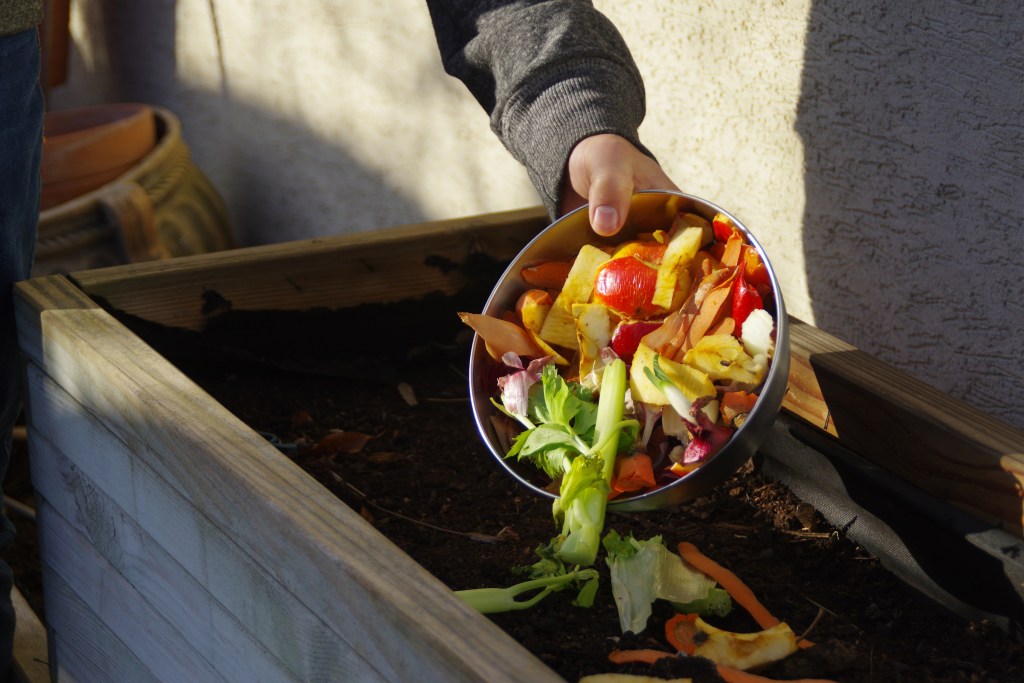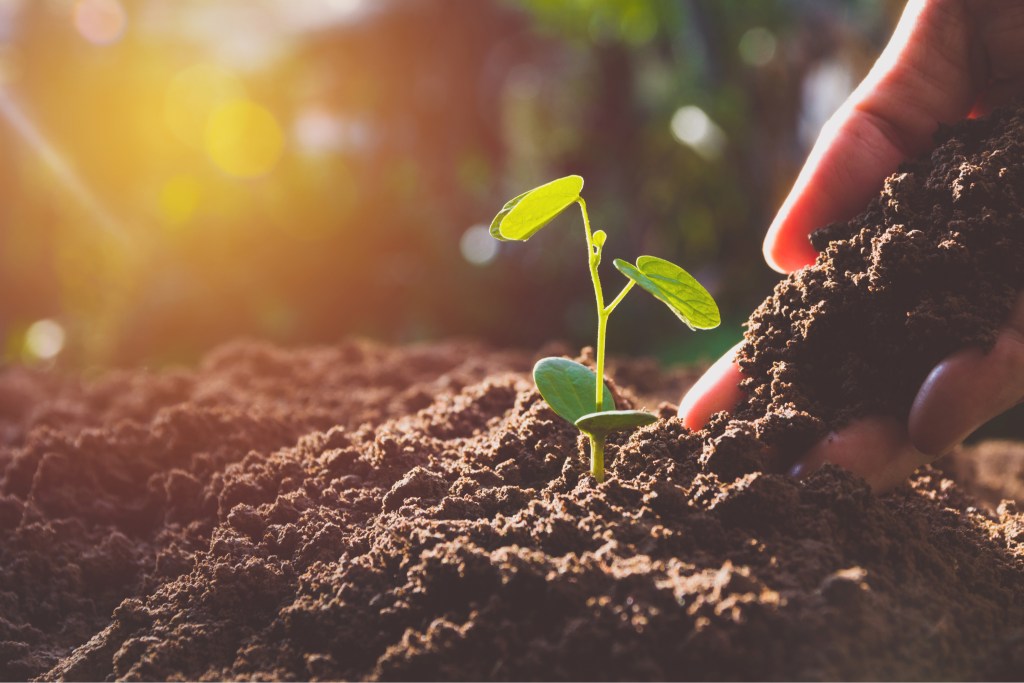Using a food scrap pickup service diverts waste from landfill sites, but it comes with a major downside: no access to the final product. For avid gardeners, composting at home transforms organic biomass into nutrient-rich compost ready for your garden.
“It’s a very satisfying feeling to have useable compost that you generated in your own yard that you know used to be food scraps,” said Kristin Field, program coordinator at the Garfield Park Conservatory.
Field coordinates volunteers in all programs and oversees the composting program. Since the onset of the pandemic, Field singlehandedly cared for the park’s compost bins.
“Back in March… we first put the pause on the composting program for volunteers,” Field said. “We still don’t have volunteers back for that specific program, so I’ve just been keeping our worms alive and happy, and managing our outdoor bins.”
Before March, the Garfield Park Conservatory hosted weekly demonstration and education events, and invited volunteers to tend worm and outdoor bins each Saturday. The Garfield Park Conservatory Alliances hopes to return these events and invite volunteers again in the future, but has since turned to virtual opportunities, including personal composting classes for organizations or small clubs, to keep their education mission alive (along with the park’s worms).
Many composting educators have been impacted by COVID-19. The Office of Sustainability and the Campus Compost Collective at Loyola University in Chicago similarly turned to online forums to spread awareness about the program and promote sustainable practices on and off-campus. With many students off-campus, the Campus Compost Collective used online tools, including GatherTown, to engage students through games while also teaching about sustainability.
“We had a little birthday event on Earth day,” said Connor Bishop, the undergraduate Campus Sustainability intern for the Office of Sustainability and rising junior at Loyola. “That’s a way we try to get people involved more with environmental issues.”
Bishop helps manage the university’s Compost Bucket Program, a free compost drop-off service for students and faculty. Each week, the Compost Bucket Program collects waste from students, faculty, and dining facilities to deliver to Organix: a food waste collector that transforms materials into compost, livestock feed, and green energy.
As a commercial system, Organix enables Loyola students and faculty to discard a larger variety of items, including animal products and oil. However, the Office of Sustainability also relies on red worm bins and other methods to reuse the organic biomass produced by their outdoor garden production and aquaponics system.
“We really depend on compost as a broad spectrum fertilizer that gets us a lot of micronutrients,” said Kevin Erickson, who manages Loyola’s urban agriculture program within the Office of Sustainability. Erickson works with campus agriculture, using compost to support healthy ecosystems and bountiful crop yields. Produce grown on campus is then sold at campus farmer’s markets.
Soil amended with compost offers numerous benefits for the health of plants and their ecosystems.
“It’ll give your plants the nutrients that they need,” Field said. “Stronger and healthier plants are better suited to dealing with stressors, so they’re a little bit more resistant to pests or things like that.”
Compost nurtures soil, virtually replacing other synthetic fertilizers and soil conditioners. Even a small amount of compost can make a noticeable difference in soil: just a five percent increase in compost in the soil quadruples its water holding capacity.

“Adding compost will hold more moisture in your soil, which is better for addressing things like erosion or water retention,” Erickson said. “It means you probably have to water less if your soil holds more moisture.”
Compost captures water runoff and sediment, acting as a sponge to reduce water pollution caused by stormwater and agricultural runoff. Organic material also improves soil structure by protecting against erosion.
While unfamiliar to some, humans have practiced composting for hundreds of years. Archeological evidence suggests humans reusing organic materials to improve soil quality may predate written history, as far back as 12 thousand years ago during the Stone Age.
Landfilling became the primary American trash removal practice only decades ago. The Fresno Sanitary Landfill, considered to be the oldest sanitary landfill in the United States, opened in California in 1937. Seen at that time as innovative, criticism regarding the sustainability of landfilling circulated by the 1970s.
“Really, we only have so much space for landfills,” Field said. “Eventually we will run out of space.”
Aside from the issue of finite space, landfills contribute to climate change by producing greenhouse gases. Organic waste doesn’t receive enough oxygen or carbon to break down in the landfill; instead, it produces methane. Methane emissions are responsible for 40 percent of climate warming since the Industrial Revolution, at a rate 84 times more powerful than carbon dioxide.
Since methane only lasts 12 years in the atmosphere, immediate efforts to curb methane emissions could significantly impact the climate crisis.
“Even if you’re not doing it perfect, composting happens whether you’re good at it or bad at it,” Field said. “You want to manage it well and you want to make sure that you’re doing it right. But even if you mess up a little bit, things are still going to break down.”
There are numerous types of composting systems; the two major types are red worm composting and basic, outdoor composting. Worm composting allows users to compost mostly fruit and vegetable scraps in little space, as small as a 1 by 1 foot bin.
“If you live in an apartment, or are thinking about moving, I might not set up an outdoor bin,” Field said. “I think worm composting bins are a great option.”
Worm composting can be performed in small spaces indoors, ideally a shady and weather-controlled area of a home or garage. Create a worm bed of moist paper or leaves in a bin, adopt some worms, and feed them. Bury about a pound of fruit and vegetable trimmings into the bedding and leave the worms alone for a couple weeks to adjust to their new home. Maintain the worm bin by providing food scraps each week and a 4 to 6 inch layer of bedding at least once every couple months. The compost will be ready for harvest in 2 to 3 months.
Basic composting must be done outdoors on soil or cement in a bin at least 3 by 3 feet. This method allows the breakdown of both food scraps and yard trimmings. Many cities have laws regulating outdoor composting, limiting the size and volume. Chicken wire, or other enclosures, must be used to prevent rats.
Composting requires four ingredients: nitrogen, carbon, oxygen, and water. Carbon and nitrogen, known as “browns” and “greens,” feed the microorganisms that break down biomass.
“The carbon nitrogen balance is important because it is basically stabilizing the biology and creating a healthy soil food web within the compost material,” Erickson said. “What you’re doing is basically creating a recipe for the bacteria, fungi, microanthropods, and different organisms to start breaking down the material.”
Regularly monitor and turn the pile to prevent anaerobic activity. For residential composting, turn the pile to add oxygen and to aid aerobic composting. Anaerobic activity produces methane, which pollutes the environment. Smell provides a great indicator of compost health.
“If you smell this rotten, sour smell, that is an indication of anaerobic activity,” Erickson said. “Most likely you’re putting in too much of the fresh material, or the green material, and not enough of the brown material, which would be like dried grasses, bark, newspaper, or dried leaves.”
Many beginners struggle to add enough brown materials, because food scraps are plentiful. However, it’s important to maintain a large supply of brown materials to promote aerobic activity.
“Instead of putting them out for pickup, just save those leaves and add them to your pile throughout the year,” Field said.
For piles that refuse to break down, the pile may be too dry or contain too much brown matter. To remedy, add water while turning the pile or add fresh green material.
“Always keep your outdoor bins the moisture consistency of a wrung-out sponge,” Field said. “You never want it too wet or too dry.”
Don’t oversaturate piles—sopping piles can smell rotten or attract flies. Turn the pile to add oxygen while also adding browns to increase carbon. Layering browns and greens helps incorporate the materials quicker. To speed up the process more, increase the surface area of materials by chopping them up.
“Imagine a full sized pumpkin versus a pumpkin that’s pureed into a million bits,” Erickson said. “The regular sized pumpkin isn’t going to do much for a long time.”
Once harvested, the compost will resemble soil; apply it to garden beds yearly, around the yard as mulch, and even lightly sifted onto house plants.

Composting, although important, can’t replace food waste reduction.
“Sometimes we forget the first two R’s of ‘Reduce, Reuse, Recycle,’” Bishop said. “We focus too much on where the waste goes than [on] lowering the waste itself.”
Food waste recycling can only be a final resort to landfill diversion, because government policy doesn’t fund the infrastructure necessary to divert every household’s organic waste. Government policy must create accessible avenues and greater incentives for individuals.
“Some cities are progressive and have systems in place through municipal systems,” Erickson said. “I think that’s the big goal, to get cities to adopt [a] more centralized role, so it’s cheaper for everyone and it’s a widespread service that’s offered to everyone.”
While considering commercial or residential methods, different systems suit different lifestyles. Composting at home can help people feel connected to the final product and can teach them about soil science. Composting is the art of transforming food back into food, or into healthier blooms.
“Another thing is when you’re hauling something away off your property, you often don’t see the full benefit of what it’s doing. You’re more looking at it as trash,” Erickson said. “Whereas if you’re breaking it down and making your own compost, you see the actual value that it’s doing.”
Composting can be a great hobby that bonds people closer to their gardens and communities.
“If you’re working all of the time,” Field said. “It’s a way to kind of play and have fun, and really be able to watch a scientific process before your eyes.”



